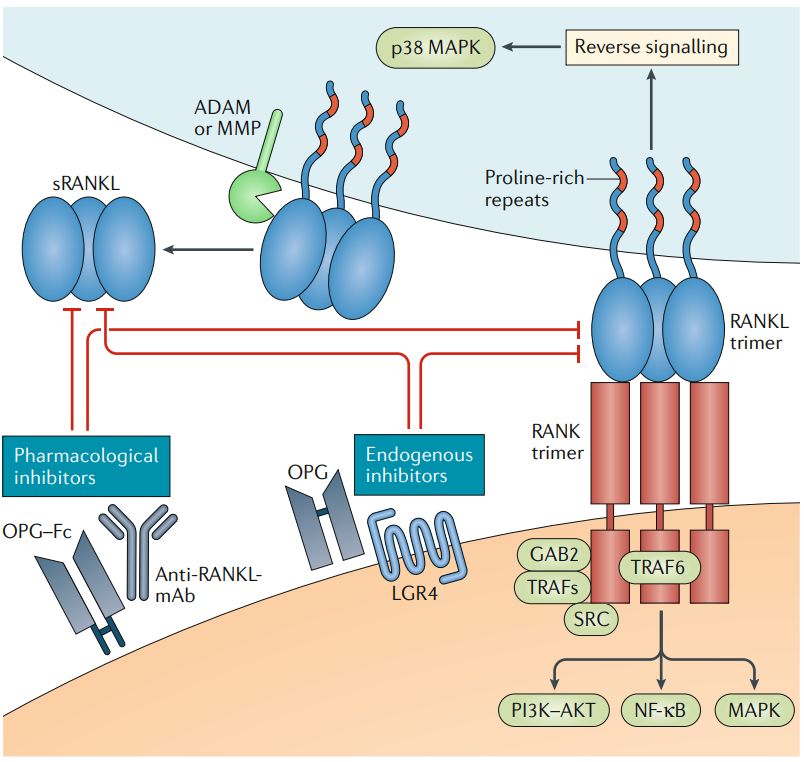What is TNFSF11 Protein
The TNFSF11 protein, also known as RANKL (Receptor Activator of Nuclear Factor Kappa-B Ligand), emerges as a pivotal regulator in molecular biology, orchestrating diverse cellular processes crucial to human health.
What is TNFSF11 Protein?
TNFSF11, a product of the TNFSF11 gene, belongs to the TNF superfamily, recognized for its role in modulating cell survival, death, immune responses, and inflammation. Predominantly expressed in T cells, B cells, and dendritic cells, TNFSF11 stands as a linchpin in the immune system, influencing critical physiological processes.
The Function of TNFSF11 Protein
- Regulating Bone Metabolism
TNFSF11 takes center stage in the realm of bone metabolism, playing a pivotal role in osteoclastogenesis—the formation of osteoclasts responsible for bone resorption. This protein engages with its receptor, RANK, on osteoclast precursor cells, initiating a complex signaling cascade. The culmination of this cascade leads to the differentiation and activation of osteoclasts, vital for maintaining bone homeostasis.
- Immunoregulation
Beyond its influence on bone physiology, TNFSF11 actively participates in immune regulation. Its impact on T cells and dendritic cells underscores its role in shaping adaptive immune responses, presenting TNFSF11 as a versatile player in orchestrating immune defense mechanisms.
TNFSF11-Related Diseases
- Osteoporosis
Dysregulation of the RANKL-RANK signaling pathway, governed by TNFSF11, is implicated in osteoporosis. Imbalances in this pathway lead to increased bone resorption, decreased bone density, and heightened susceptibility to fractures. The recognition of TNFSF11's involvement in osteoporosis has paved the way for targeted therapeutic strategies, with denosumab, a monoclonal antibody inhibiting RANKL, demonstrating efficacy in clinical applications.
- Rheumatoid Arthritis
TNFSF11 emerges as a key player in autoimmune diseases like rheumatoid arthritis. In this context, its dysregulated expression contributes to joint inflammation and bone erosion. Biologics targeting TNFSF11, such as denosumab, offer a promising avenue for managing rheumatoid arthritis by mitigating osteoclast activity and reducing bone destruction.
- Breast Cancer and Bone Metastasis
The RANKL-RANK pathway, orchestrated by TNFSF11, features prominently in the context of cancer, particularly breast cancer. TNFSF11 promotes osteoclastogenesis, creating an environment conducive to bone metastasis. Therapeutic interventions targeting TNFSF11 aim to curb bone metastasis and enhance the quality of life for cancer patients.
TNFSF11 Related Signaling Pathways
The intricate signaling pathway activated by TNFSF11 is a finely tuned mechanism governing both bone metabolism and immune responses.
- NF-κB Pathway
Upon TNFSF11 binding to RANK, the NF-κB pathway is activated, leading to the expression of genes crucial for osteoclast differentiation and activation. This pathway plays a central role in mediating the effects of TNFSF11 on bone metabolism.
- MAPK Pathway
The MAPK pathway, another key player in the signaling cascade initiated by TNFSF11, further contributes to the regulation of osteoclastogenesis. These pathways collectively underscore the complexity and precision inherent in the molecular mechanisms orchestrated by TNFSF11.

Figure 1. RanKl–RanK interaction and its inhibitors. (Ahern, E., et al. 2018)
Applications of TNFSF11 in Biomedical Research
- Targeted Therapies
TNFSF11's pivotal role in bone metabolism and immune regulation positions it as a promising target for therapeutic interventions. Denosumab, a monoclonal antibody inhibiting RANKL, has emerged as a breakthrough in the treatment of osteoporosis and certain cancers. By selectively modulating TNFSF11 activity, denosumab prevents excessive bone resorption, offering targeted therapeutic benefits.
- Cancer Treatment
The inhibition of TNFSF11 holds promise in cancer treatment, especially in mitigating bone metastasis. Therapies targeting the RANKL-RANK pathway aim to suppress skeletal-related events in cancer patients, opening new avenues for personalized and targeted cancer treatments.
- Immunomodulation
TNFSF11's role in immune regulation suggests potential applications in immunomodulation. Exploring strategies to modulate TNFSF11 activity could pave the way for innovative treatments for autoimmune diseases, where precise control of immune responses is paramount.
The TNFSF11 protein emerges as a linchpin in cellular processes, influencing both bone metabolism and immune regulation. Its intricate signaling pathways unveil a tapestry of molecular events crucial to human health. As we continue to unravel the intricacies of TNFSF11, we unlock the potential for transformative breakthroughs in the realm of personalized medicine and disease management.
Recommended Products for TNFSF11 Protein
Reference
- Ahern, E., et al. Roles of the RANKL–RANK axis in antitumour immunity — implications for therapy. Nat Rev Clin Oncol.2018, 15: 676–693.

